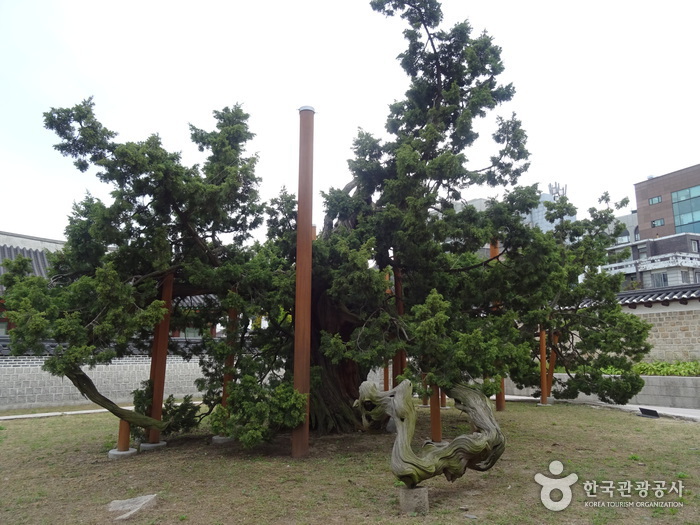Hyangnamu Tree in Changdeokgung Palace (창덕궁 향나무)
6.5Km 2025-01-13
99, Yulgok-ro, Jongno-gu, Seoul
+82-2-3668-2300
Hyangnamu or 'Aromatic Tree' in Changdeokgung Palace is estimated to be about 700 years old, meaning it had likely been planted before the palace was built. It stands 12m in x_height, measures 5.9m in girth around the roots, and has branches spreading in all four directions. It is designated and protected as a National Natural Monument.
Soda - Hyundai Dongdaemun Branch [Tax Refund Shop] (소다 현대동대문점)
6.5Km 2024-04-22
3F, 20, Jangchungdan-ro 13-gil, Jung-gu, Seoul
-
KL - Hyundai Outlets Dongdaemun Branch [Tax Refund Shop] (KL 현대아울렛동대문점)
6.5Km 2024-04-16
3F Hyundai City Outlet Dongdaemun Branch, 20, Jangchungdan-ro 13-gil, Jung-gu, Seoul
-
Zio Songzio - Hyundai Dongdaemun Branch [Tax Refund Shop] (지오송지오 현대동대문)
6.5Km 2024-04-22
6F, 20, Jangchungdan-ro 13-gil, Jung-gu, Seoul
-
The Handsome Mine - Hyundai Dongdaemun Branch [Tax Refund Shop] (한섬 마인 현대동대문)
6.5Km 2024-04-17
Hyundai City Outlet Dongdaemun Branch, 20, Jangchungdan-ro 13-gil, Jung-gu, Seoul
-
Demoo - Hyundai Dongdaemun Branch [Tax Refund Shop] (데무 현대동대문)
6.5Km 2024-04-17
3F, 20, Jangchungdan-ro 13-gil, Jung-gu, Seoul
-
Daehyun Zooc - Hyundai Dongdaemun Branch [Tax Refund Shop] (대현 쥬크 현대동대문)
6.5Km 2024-04-17
Hyundai City Outlet Dongdaemun Branch, 20, Jangchungdan-ro 13-gil, Jung-gu, Seoul
-
Olens - Hyundai Dongdaemun Branch [Tax Refund Shop] (오렌즈 현대동대문)
6.5Km 2024-04-22
B1 (Hyundai City Outlet Dongdaemun Branch, Eulji-ro 6-ga), 20, Jangchungdan-ro 13-gil, Jung-gu, Seoul
-
Trugen - Hyundai Dongdaemun Branch [Tax Refund Shop] (트루젠 현대동대문)
6.5Km 2024-04-18
20, Jangchungdan-ro 13-gil, Jung-gu, Seoul
-
Venus - Hyundai Dongdaemun Branch [Tax Refund Shop] (비너스 현대동대문)
6.5Km 2024-04-18
20, Jangchungdan-ro 13-gil, Jung-gu, Seoul
-

![Soda - Hyundai Dongdaemun Branch [Tax Refund Shop] (소다 현대동대문점)](http://tong.visitkorea.or.kr/cms/resource/96/2887796_image2_1.jpg)
![KL - Hyundai Outlets Dongdaemun Branch [Tax Refund Shop] (KL 현대아울렛동대문점)](http://tong.visitkorea.or.kr/cms/resource/06/2887806_image2_1.jpg)
![Zio Songzio - Hyundai Dongdaemun Branch [Tax Refund Shop] (지오송지오 현대동대문)](http://tong.visitkorea.or.kr/cms/resource/26/2888926_image2_1.jpg)
![The Handsome Mine - Hyundai Dongdaemun Branch [Tax Refund Shop] (한섬 마인 현대동대문)](http://tong.visitkorea.or.kr/cms/resource/55/2888055_image2_1.jpg)
![Demoo - Hyundai Dongdaemun Branch [Tax Refund Shop] (데무 현대동대문)](http://tong.visitkorea.or.kr/cms/resource/75/2888075_image2_1.jpg)
![Daehyun Zooc - Hyundai Dongdaemun Branch [Tax Refund Shop] (대현 쥬크 현대동대문)](http://tong.visitkorea.or.kr/cms/resource/95/2888095_image2_1.jpg)
![Olens - Hyundai Dongdaemun Branch [Tax Refund Shop] (오렌즈 현대동대문)](http://tong.visitkorea.or.kr/cms/resource/31/2889131_image2_1.jpg)
![Trugen - Hyundai Dongdaemun Branch [Tax Refund Shop] (트루젠 현대동대문)](http://tong.visitkorea.or.kr/cms/resource/48/2889148_image2_1.jpg)
![Venus - Hyundai Dongdaemun Branch [Tax Refund Shop] (비너스 현대동대문)](http://tong.visitkorea.or.kr/cms/resource/91/2889191_image2_1.jpg)
 English
English
 한국어
한국어 日本語
日本語 中文(简体)
中文(简体) Deutsch
Deutsch Français
Français Español
Español Русский
Русский